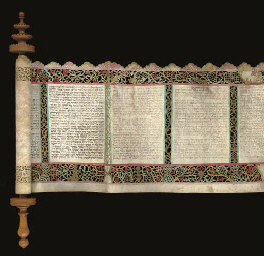HEBREW MANUSCRIPT. Esther Scroll. Engraved Megillat Esther by Salom Italia. Amsterdam, ca. 1641. Printed in black ink on vellum, 3 membranes, 132 mm. high, 2075 mm. long. 24 columns, (61 x 38 mm.) of 28 lines. Mounted on carved wooden roller 285 mm. high. Opening section of the scroll darkened, slightly creased and worn. Small piece missing from end of scroll, virtually no loss of decoration. Sewn band attached to beginning. DECORATION The megillah opens with an elaborate introductory panel that displays two scrolled cartouches topped by a plumed knight's helmet, and supported by a pair of winged, seated female figures, each carrying a trumpet. Beneath the cartouches, which contain the blessings recited before the scroll's reading, is a banner inscribed "Salom Italia sculp". A row of six birds form a triangular (yet uncut) outer contour. The megillah's text columns are framed by a series of twenty-four ornate portals, each topped by a broken pediment adorned with bearded profile masks and centered by a floral vase. Two female figures holding branches recline atop each pediment's arches. Full-length characters from the Purim narrative, facing left and right alternately, stand in rounded archways set between the monumental portals. Miniature landscape and townscape scenes that incorporate several characteristically Dutch elements, such as windmills and ships, appear in frames beneath these figures and in cartouches centered above each text column. The famous Jewish engraver Salom Italia exerted unprecedented influence over the history of Esther scroll decoration and illustration. Born in Lisbon, Portugal and trained in Italy (Mantua and perhaps the Venetian States), he arrived in Amsterdam in 1641. It was there that he designed a series of engraved Esther scroll borders that would greatly affect megillah decoration throughout the European Continent. The present border displays several of Italia's most characteristic and influential innovations in Esther scroll decoration: the framing of the text panels by monumental archways (often modeled on those erected for triumphal entries, possibly alluding to the triumph of the Persian Jews over Haman, or the triumphal procession of Mordecai through the streets of Shushan), the positioning of full-length figures between the text panels, and the repetition of framed land- and townscape scenes along the scroll's upper or lower borders. Each of these elements became exceedingly popular in later European Esther scrolls, whether engraved or hand-painted. VERY RARE. Not in the extensive Esther scroll holdings of JTS or The Jewish Museum, NY. Literature - M. Narkiss. "The Oeuvre of the Jewish Engraver Salom Italia (1619-1655?)," Tarbiz 24, 4, 1956, no. 5, fig. 5. - N. Kleeblat & V.B. Mann (eds), Treasures of the Jewish Museum , New York, 1986; see no. 64 for a related scroll.
HEBREW MANUSCRIPT. Esther Scroll. Engraved Megillat Esther by Salom Italia. Amsterdam, ca. 1641. Printed in black ink on vellum, 3 membranes, 132 mm. high, 2075 mm. long. 24 columns, (61 x 38 mm.) of 28 lines. Mounted on carved wooden roller 285 mm. high. Opening section of the scroll darkened, slightly creased and worn. Small piece missing from end of scroll, virtually no loss of decoration. Sewn band attached to beginning. DECORATION The megillah opens with an elaborate introductory panel that displays two scrolled cartouches topped by a plumed knight's helmet, and supported by a pair of winged, seated female figures, each carrying a trumpet. Beneath the cartouches, which contain the blessings recited before the scroll's reading, is a banner inscribed "Salom Italia sculp". A row of six birds form a triangular (yet uncut) outer contour. The megillah's text columns are framed by a series of twenty-four ornate portals, each topped by a broken pediment adorned with bearded profile masks and centered by a floral vase. Two female figures holding branches recline atop each pediment's arches. Full-length characters from the Purim narrative, facing left and right alternately, stand in rounded archways set between the monumental portals. Miniature landscape and townscape scenes that incorporate several characteristically Dutch elements, such as windmills and ships, appear in frames beneath these figures and in cartouches centered above each text column. The famous Jewish engraver Salom Italia exerted unprecedented influence over the history of Esther scroll decoration and illustration. Born in Lisbon, Portugal and trained in Italy (Mantua and perhaps the Venetian States), he arrived in Amsterdam in 1641. It was there that he designed a series of engraved Esther scroll borders that would greatly affect megillah decoration throughout the European Continent. The present border displays several of Italia's most characteristic and influential innovations in Esther scroll decoration: the framing of the text panels by monumental archways (often modeled on those erected for triumphal entries, possibly alluding to the triumph of the Persian Jews over Haman, or the triumphal procession of Mordecai through the streets of Shushan), the positioning of full-length figures between the text panels, and the repetition of framed land- and townscape scenes along the scroll's upper or lower borders. Each of these elements became exceedingly popular in later European Esther scrolls, whether engraved or hand-painted. VERY RARE. Not in the extensive Esther scroll holdings of JTS or The Jewish Museum, NY. Literature - M. Narkiss. "The Oeuvre of the Jewish Engraver Salom Italia (1619-1655?)," Tarbiz 24, 4, 1956, no. 5, fig. 5. - N. Kleeblat & V.B. Mann (eds), Treasures of the Jewish Museum , New York, 1986; see no. 64 for a related scroll.















Try LotSearch and its premium features for 7 days - without any costs!
Be notified automatically about new items in upcoming auctions.
Create an alert